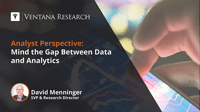In today’s data-driven world, organizations need real-time access to up-to-date, high-quality data and analysis to keep pace with changing market dynamics and make better strategic decisions. By mining meaningful insights from enterprise data quickly, they gain a competitive advantage in the market. Yet, organizations face a multitude of challenges when transitioning into an analytics-driven enterprise. Our Analytics and Data Benchmark Research shows that more than one-quarter of organizations...
Read More
Topics:
embedded analytics,
Analytics,
Business Intelligence,
IBM,
IBM Watson,
AI & Machine Learning
In my previous perspectives on cloud computing, I addressed some of the realities of cloud costs as well as hybrid and multi-cloud architectures. In the midst of the pandemic, my colleague, Mark Smith, authored a series of perspectives on considerations for business continuity in general, beginning with this look at some of the investments organizations must make to mitigate the risk of business disruptions. In this perspective, I’d like to address some of the realities of business continuity...
Read More
Topics:
Business Continuity,
Cloud Computing,
Digital Technology,
Digital Business
If you’ve ever been to London, you are probably familiar with the announcements on the London Underground to “mind the gap” between the trains and the platform. I suggest we also need to mind the gap between data and analytics. These worlds are often disconnected in organizations and, as a result, it limits their effectiveness and agility.
Read More
Topics:
business intelligence,
embedded analytics,
Analytics,
Data Governance,
Data Management,
data operations,
Analytics & Data












